Gallery
- Typophyllum laciniosum, Tambopata National Reserve, Peru
- Aegimia elongata
- Pycnopalpa bicordata, Trinidad
- Onomarchus kanara
There are many insects in the family Tettigoniidae (bush crickets or katydids) which are mimics of leaves. [1]
This type of camouflage occurs in several subfamilies, among others including:
Other unrelated insects adopting a similar camouflage strategy include the leaf insects.

Insects in the family Tettigoniidae are commonly called katydids, or bush crickets. They have previously been known as "long-horned grasshoppers". More than 8,000 species are known. Part of the suborder Ensifera, the Tettigoniidae are the only extant (living) family in the superfamily Tettigonioidea.

Orthoptera is an order of insects that comprises the grasshoppers, locusts, and crickets, including closely related insects, such as the bush crickets or katydids and wētā. The order is subdivided into two suborders: Caelifera – grasshoppers, locusts, and close relatives; and Ensifera – crickets and close relatives.

Ensifera is a suborder of insects that includes the various types of crickets and their allies including: true crickets, camel crickets, bush crickets or katydids, grigs, weta and Cooloola monsters. This and the suborder Caelifera make up the order Orthoptera. Ensifera is believed to be a more ancient group than Caelifera, with its origins in the Carboniferous period, the split having occurred at the end of the Permian period. Unlike the Caelifera, the Ensifera contain numerous members that are partially carnivorous, feeding on other insects, as well as plants.
Katydid is the common name for insects of the family Tettigoniidae, including
Orthopteroids are insects which historically would have been included in the order Orthoptera and now may be placed in the Polyneoptera. When Carl Linnaeus started applying binomial names to animals in the 10th edition of his Systema Naturae in 1758, there were few animals included in the scheme, and consequently few groups. As more and more new species were discovered and differences recognised, the original groups proposed by Linnaeus were split up.

Macroxiphus is a small genus of bush crickets or katydids distributed in Southeast Asia and Micronesia. The nymphs of the insects mimic ants.

The subfamily Pseudophyllinae contains numerous species in the family Tettigoniidae, the katydids or bush crickets. Sometimes called "true katydids", together with the crickets of suborder Ensifera, they form part of the insect order Orthoptera which also contains grasshoppers.

Acanthoplus discoidalis is a species in the Hetrodinae, a subfamily of the katydid family (Tettigoniidae). Like its closest relatives, Acanthoplus discoidalis variously bears common names such as armoured katydid, armoured ground cricket, armoured bush cricket, corn cricket, setotojane and koringkriek. The species is native to parts of Angola, Namibia, Botswana, Zimbabwe and South Africa.
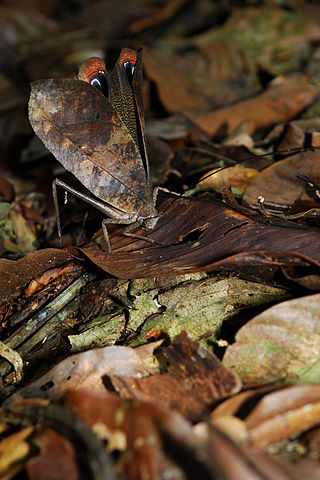
Pterochroza ocellata, the peacock katydid, is an insect in the family Tettigoniidae. The species is a leaf-mimic katydid; when it is in repose its camouflage resembles a diseased or dead leaf. The katydid owes both its common name and its specific epithet to its startle display, in which it shows false eye spots on its normally hidden hind wings.
Panoploscelis is a genus of very large insects belonging to the true katydid tribe Eucocconotini, which is a subfamily of the Tettigoniidae. Like the other members of the suborder Ensifera, Panoploscelis are part of the insect order Orthoptera, which also contains crickets, grasshoppers and locusts. Members of this genus are among the largest katydids of the Neotropics.
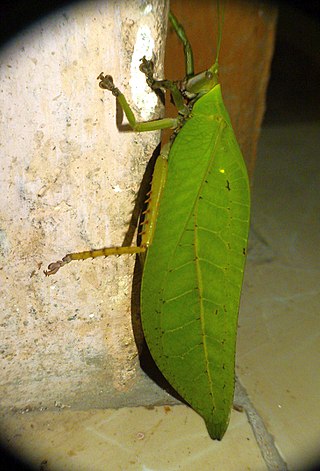
Onomarchus is a genus of bush crickets or katydids found mainly distributed in the tropical forests of Asia. Like many other members of the subfamily Pseudophyllinae, their wings appear very leaf-like.

Sathrophyllia is a genus of Asian bush crickets or katydids in the subfamily Pseudophyllinae and tribe Cymatomerini. They are usually found on the branches of bushes or trees where they sit close to a branch and spread out their forelegs and antennae along the branch and hold themselves close to the surface with their middle pair of legs. Some species like S. rugosa have cryptic colouration that matches the bark making them very hard to spot. Further east, the genus Olcinia also bears a close resemblance, however Sathrophyllia has a relatively smooth margin to the forewing unlike that of Olcinia.

Mecopodinae are a subfamily of bush crickets found in western South America, sub-Saharan Africa, and Asia. In Asia, the distribution includes India, Indochina, Japan, the Philippines, and Malesia to Papua New Guinea and Australasia, including many Pacific islands.
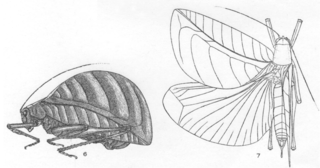
Eulophophyllum is a genus of leaf mimicking bush crickets or katydids in the subfamily Phaneropterinae. It was originally circumscribed in 1922 by Morgan Hebard as a monospecific genus for the species E. thaumasium, but two new species were described and added to the genus in 2016.

Pterophylla camellifolia, the common true katydid, is a common North American insect in the family Tettigoniidae (katydids). Within the Tettigoniidae, it belongs to the subfamily Pseudophyllinae. Other common names include northern true katydid and rough-winged katydid.

The Pterochrozinae are a subfamily of the Tettigoniidae found in Central and South America. They were previously placed as a tribe in the subfamily Pseudophyllinae and have been called "leaf-mimic katydids".
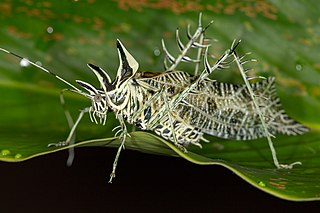
Markia is a genus of katydids found in Mexico, Central America and South America, often in highlands. They are known as lichen katydids, a name also used for some other genera in the tribe Dysoniini. As suggested by the name, the spiny Markia katydids live and feed on Usnea lichen, and their shape and color pattern provides them with an excellent camouflage in this habitat. They are quite large, with adults typically 4.5–6.5 cm (1.8–2.6 in) long.

Caedicia simplex is a species of bush cricket, native to New Zealand and Australia. Its common name is the common garden katydid.

Pterophylla is a genus of true katydids in the family Tettigoniidae. There are about five described species in Pterophylla.
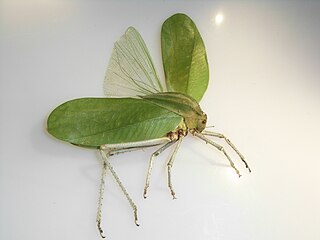
Siliquofera is a genus of bush cricket in the subfamily Phyllophorinae that includes only one species, Siliquofera grandis, which is fairly common and widespread in rainforest canopies of New Guinea and nearby smaller islands, and seemingly rare in Australia where only found in the remote Iron Range region. This very well-camouflaged, green and leaf-like bush cricket is one of the world's largest Orthoptera, with adults typically having a length of 10.7–13 cm (4.2–5.1 in) and a wingspan of 25–27 cm (9.8–10.6 in); it can weigh more than 30 g (1.1 oz).